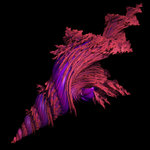| Author
|
snare compression
|
Medea
Aedem/Medea

Started Topics :
127
Posts :
1132
Posted : Jan 21, 2009 11:03
|
PSP Vintage Warmer works ok on snares often. It has a preset called "Funky snare drum", makes the snare very big 
        http://soundcloud.com/aedem http://soundcloud.com/aedem |

|
|
gutter
Inactive User

Started Topics :
54
Posts :
3018
Posted : Jan 21, 2009 11:08
|
+1000 some smooth distortion/saturation gives a lot of life on percussive sounds 
|

|
|
Speakafreaka
IsraTrance Junior Member

Started Topics :
18
Posts :
779
Posted : Jan 21, 2009 11:46
|
Noise gate so that it feels tight with tempo.
compress in such a way as you let the click through and pancake what follows.
I can't give precise measurements, because it all depends on the compressor and the snare. Typically somewhere around 5-10ms attack, fast release quite high ratio, and threshold down as far as still makes sonic sense!
LP to beneath 'tone' of snare (circa 100-200hz).
Notch out the steady freq in the circa 100-200 area.
Fling through a tape saturator (I really like the magix AM-Track for snares). You are looking for the amount of drive before the tops disintegrate into noise (otherwise you might as well be using noise, innit  ). ).
By doing this, you are effectively tapesaturating the transients and start of the snare most strongly, whilst not really distorting the body - smoothing it out.
Now re-boost at the steady freq you notched out.
Reverb on a send channel - mainly early reflections, maybe a smidge of your tail, but early reflections are the key, to make it sound denser.
Enjoy 
        . .
http://www.soundcloud.com/speakafreaka |

|
|
Nectarios
Martian Arts

Started Topics :
187
Posts :
5292
Posted : Jan 21, 2009 13:06
|
Choosing the right snare sample for your track is obviously the way to start. After that there are no general settings. A 909 snare would have me dialing in a slightly slower attack and a relative threshold/ratio that allows a bit of the transient through and makes it snappy. Some snare with a massive transient would have me using a FET compressor with a really fast attack, higher ratio and higher threshold setting, in order to tame the massive transient.
Adn I high pass all my snares above 200hz. I don't want any low mid messing with my kick.
A find a tight gated reverb works a treat.
       
http://soundcloud.com/martianarts |

|
|
gutter
Inactive User

Started Topics :
54
Posts :
3018
Posted : Jan 21, 2009 13:55
|
Quote:
| A find a tight gated reverb works a treat. |
|
care to explain the use for that gated verb please?
do you use a gate after the reverb in the fx track for closing a big decay of the effect for example, or can it make a more "clean" reverb? ive never used it and try to think what can be used for, ive put a comp/lim and then eq but never a gate, really have to try it. thanx
|

|
|
Nectarios
Martian Arts

Started Topics :
187
Posts :
5292
Posted : Jan 21, 2009 17:05
|
there are ready made algorithms that simulate a dense reverb shuting off abruptly. think it was peter gabriel's engineer or phil collin's that came up with it in the 80s. its basicaly a thick reverb going into a gate with a fast release time and high threshold, that shuts it off quickly, at a rather high level.
space designer has some great ones, as does Lexicon MPX-1 and the Lexicon PCM 81 and Eventide Eclipse have the best ones...if you can spare a few grand for reverbs...
       
http://soundcloud.com/martianarts |

|
|
jizy
IsraTrance Full Member

Started Topics :
90
Posts :
1493
Posted : Jan 21, 2009 20:54
|
|
mmm interesting stuff ere lads thanks for the insights
|

|
|
Kitnam
Mantik

Started Topics :
110
Posts :
1151
Posted : Jan 21, 2009 23:45
|
remember that your snaredrum-mixing depends heavily on your kickdrum-mixing. and it depends a lot on the hihat-editing to make it finally "rolling", deadnotes help there too.
i made good experiences with hell of a lowcut (depends on the sample) and giving it a peak with a coloring eq at 5-9 Khz.
your reverb is very important too and sometimes a few dead samples around it to make the snare-impact more interesting, especially in techhouse-productions (where the bpms are lower and samples have more room). your reverb should generally be very short and expand the release of your snare in a more 3-dimensional way, and more in a way of feeling, not hearing. stacking reverbs on snaredrum is a common technique by the way but generally start with one only until you know exactly what you do.
compression:
go with this mantra: there are no formulars of how to use compressors because it depends to much on the signal envelopes/trackspeed/signal gain/signal rythm/compressor-type itself! (because of the different curves!)
but here is what are maybe the goals if you want to compress snares:
- giving the transients more impact
- cutting the release
- reducing the impact of low frequences without equing them
- reducing the generall impact of the snare
- ...
i would highly recommend you to fully try to understand how compression works - this may sound not so funny and helpfull but you can adapt things on your own then and on the other side its not possible to use compression after some kind of number-formular. for example for snares your releasetime should be faster than a new snarehit comes a long otherwise you will hear your first snaredrum louder as all the following behind (which depends on the trackspeed). putting release too high is common mistake in audioproduction. the attack is the gate for your transients, the way it catches depends heavily on the compressor-type so if someone say 30 ms are great it may only work for his own compressor but not for yours. this happens, because every compressors has a different ratio-curve, the are not linear or mathematically identical very often. some of them even add saturation differently depending on the attacktime.
|

|
|
PoM
IsraTrance Full Member

Started Topics :
162
Posts :
8087
Posted : Jan 22, 2009 03:26
|
a other goal is to reduce the transients with fast attack (or distortion) , sound good sometimes (too much transient sound agressive ,softer sound make you want to crank up the volume more and it s a good thing to me than the oposite )reducing the transients you ll end up with a bigger sound cause the transient stay a the same lvl but not the rest of the sample who go louder
try a distortion after a first reverb (then add a other one )sound good depending the snare and the settings you use . |

|
|
ThiagoNAKA
IsraTrance Full Member

Started Topics :
104
Posts :
1047
Posted : Jan 22, 2009 16:02
|
Quote:
|
On 2009-01-22 03:26, PoM wrote:)reducing the transients you ll end up with a bigger sound cause the transient stay a the same lvl
|
|
I´m not 100% with this.
I often use transient shapers to tame some transients. But if u use too much(so u can crank up the volume with no clip) u will end with a "dead" sound. Overcompressed type.
Big snare sounds still has a proeminent transient. At least from my experience.
Putting a Distortion after the Reverb can produce nice splash feelling. But u need to make the reverb tail very dense with the distortion, so it will sound like the tail of snare actually. So u can use another reverb after just to place the snare at your track.
        LOADING... LOADING... |

|
|
PoM
IsraTrance Full Member

Started Topics :
162
Posts :
8087
Posted : Jan 22, 2009 17:34
|
|
yes for the transients it might be a matter of taste ,some analog gears really make the sound flat depends how much you push them , it s one of the reason it sound more pleasant imo ,for the snare at the same time as the kick it s the effect i like , a big flat splash that don t sound harsh (that kind of snare that sound a bit like a clap ,i might boost the attack with a eq sometimes) |

|
|
shellbound
IsraTrance Junior Member

Started Topics :
14
Posts :
601
Posted : Jan 22, 2009 20:15
|
Quote:
|
but here is what are maybe the goals if you want to compress snares:
- cutting the release
|
|
can someone please explain what the advantage is of doing this with a compressor instead of the sampler's envelope? |

|
|
Kitnam
Mantik

Started Topics :
110
Posts :
1151
Posted : Jan 23, 2009 08:06
|
Quote:
|
On 2009-01-22 20:15, septa wrote:
Quote:
|
but here is what are maybe the goals if you want to compress snares:
- cutting the release
|
|
can someone please explain what the advantage is of doing this with a compressor instead of the sampler's envelope?
|
|
the ratio-curve. your sampler maybe only supports a straight line or some half-bell while your compressor (depending on the type) gives the release a very unique sounding round-down. the curve would even be more complex if you start to stack different types of compression.
|

|
|
Boobytrip
IsraTrance Junior Member

Started Topics :
39
Posts :
988
Posted : Jan 23, 2009 23:52
|
|
Maybe flipping through you snare directory while playing the snare against the rest of you track will preempt the need for most processing. Using only minimal "fix-up" compression and EQ (if any at all) on the best fitting snare in your arsenal will probably yield the best results. |

|
|
Alien Bug
IsraTrance Junior Member

Started Topics :
27
Posts :
682
Posted : Jan 24, 2009 03:14
|
|